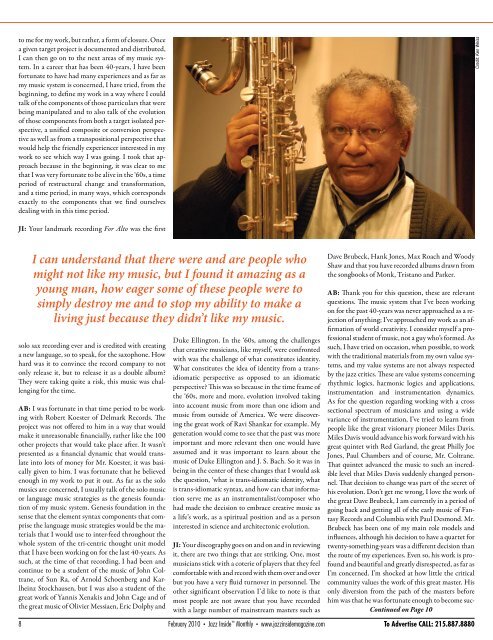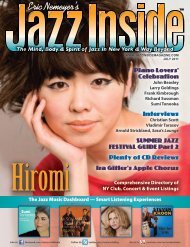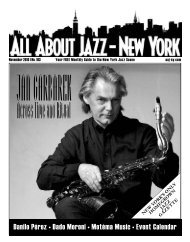February 2010 issue - Jazz Singers.com
February 2010 issue - Jazz Singers.com
February 2010 issue - Jazz Singers.com
Create successful ePaper yourself
Turn your PDF publications into a flip-book with our unique Google optimized e-Paper software.
to me for my work, but rather, a form of closure. Once<br />
a given target project is documented and distributed,<br />
I can then go on to the next areas of my music system.<br />
In a career that has been 40-years, I have been<br />
fortunate to have had many experiences and as far as<br />
my music system is concerned, I have tried, from the<br />
beginning, to define my work in a way where I could<br />
talk of the <strong>com</strong>ponents of those particulars that were<br />
being manipulated and to also talk of the evolution<br />
of those <strong>com</strong>ponents from both a target isolated perspective,<br />
a unified <strong>com</strong>posite or conversion perspective<br />
as well as from a transpositional perspective that<br />
would help the friendly experiencer interested in my<br />
work to see which way I was going. I took that approach<br />
because in the beginning, it was clear to me<br />
that I was very fortunate to be alive in the ‘60s, a time<br />
period of restructural change and transformation,<br />
and a time period, in many ways, which corresponds<br />
exactly to the <strong>com</strong>ponents that we find ourselves<br />
dealing with in this time period.<br />
JI: Your landmark recording For Alto was the first<br />
I can understand that there were and are people who<br />
might not like my music, but I found it amazing as a<br />
young man, how eager some of these people were to<br />
simply destroy me and to stop my ability to make a<br />
living just because they didn’t like my music.<br />
solo sax recording ever and is credited with creating<br />
a new language, so to speak, for the saxophone. How<br />
hard was it to convince the record <strong>com</strong>pany to not<br />
only release it, but to release it as a double album?<br />
They were taking quite a risk, this music was challenging<br />
for the time.<br />
AB: I was fortunate in that time period to be working<br />
with Robert Koester of Delmark Records. The<br />
project was not offered to him in a way that would<br />
make it unreasonable financially, rather like the 100<br />
other projects that would take place after. It wasn’t<br />
presented as a financial dynamic that would translate<br />
into lots of money for Mr. Koester, it was basically<br />
given to him. I was fortunate that he believed<br />
enough in my work to put it out. As far as the solo<br />
musics are concerned, I usually talk of the solo music<br />
or language music strategies as the genesis foundation<br />
of my music system. Genesis foundation in the<br />
sense that the element syntax <strong>com</strong>ponents that <strong>com</strong>prise<br />
the language music strategies would be the materials<br />
that I would use to inter-feed throughout the<br />
whole system of the tri-centric thought unit model<br />
that I have been working on for the last 40-years. As<br />
such, at the time of that recording, I had been and<br />
continue to be a student of the music of John Coltrane,<br />
of Sun Ra, of Arnold Schoenberg and Karlheinz<br />
Stockhausen, but I was also a student of the<br />
great work of Yannis Xenakis and John Cage and of<br />
the great music of Olivier Messiaen, Eric Dolphy and<br />
Duke Ellington. In the ‘60s, among the challenges<br />
that creative musicians, like myself, were confronted<br />
with was the challenge of what constitutes identity.<br />
What constitutes the idea of identity from a transidiomatic<br />
perspective as opposed to an idiomatic<br />
perspective? This was so because in the time frame of<br />
the ‘60s, more and more, evolution involved taking<br />
into account music from more than one idiom and<br />
music from outside of America. We were discovering<br />
the great work of Ravi Shankar for example. My<br />
generation would <strong>com</strong>e to see that the past was more<br />
important and more relevant then one would have<br />
assumed and it was important to learn about the<br />
music of Duke Ellington and J. S. Bach. So it was in<br />
being in the center of these changes that I would ask<br />
the question, ‘what is trans-idiomatic identity, what<br />
is trans-idiomatic syntax, and how can that information<br />
serve me as an instrumentalist/<strong>com</strong>poser who<br />
had made the decision to embrace creative music as<br />
a life’s work, as a spiritual position and as a person<br />
interested in science and architectonic evolution.<br />
JI: Your discography goes on and on and in reviewing<br />
it, there are two things that are striking. One, most<br />
musicians stick with a coterie of players that they feel<br />
<strong>com</strong>fortable with and record with them over and over<br />
but you have a very fluid turnover in personnel. The<br />
other significant observation I’d like to note is that<br />
most people are not aware that you have recorded<br />
with a large number of mainstream masters such as<br />
Dave Brubeck, Hank Jones, Max Roach and Woody<br />
Shaw and that you have recorded albums drawn from<br />
the songbooks of Monk, Tristano and Parker.<br />
AB: Thank you for this question, these are relevant<br />
questions. The music system that I’ve been working<br />
on for the past 40-years was never approached as a rejection<br />
of anything; I’ve approached my work as an affirmation<br />
of world creativity. I consider myself a professional<br />
student of music, not a guy who’s formed. As<br />
such, I have tried on occasion, when possible, to work<br />
with the traditional materials from my own value systems,<br />
and my value systems are not always respected<br />
by the jazz critics. These are value systems concerning<br />
rhythmic logics, harmonic logics and applications,<br />
instrumentation and instrumentation dynamics.<br />
As for the question regarding working with a cross<br />
sectional spectrum of musicians and using a wide<br />
variance of instrumentation, I’ve tried to learn from<br />
people like the great visionary pioneer Miles Davis.<br />
Miles Davis would advance his work forward with his<br />
great quintet with Red Garland, the great Philly Joe<br />
Jones, Paul Chambers and of course, Mr. Coltrane.<br />
That quintet advanced the music to such an incredible<br />
level that Miles Davis suddenly changed personnel.<br />
That decision to change was part of the secret of<br />
his evolution. Don’t get me wrong, I love the work of<br />
the great Dave Brubeck, I am currently in a period of<br />
going back and getting all of the early music of Fantasy<br />
Records and Columbia with Paul Desmond. Mr.<br />
Brubeck has been one of my main role models and<br />
influences, although his decision to have a quartet for<br />
twenty-something-years was a different decision than<br />
the route of my experiences. Even so, his work is profound<br />
and beautiful and greatly disrespected, as far as<br />
I’m concerned. I’m shocked at how little the critical<br />
<strong>com</strong>munity values the work of this great master. His<br />
only diversion from the path of the masters before<br />
him was that he was fortunate enough to be<strong>com</strong>e suc-<br />
Continued on Page 10<br />
8 <strong>February</strong> <strong>2010</strong> • <strong>Jazz</strong> Inside Monthly • www.jazzinsidemagazine.<strong>com</strong> To Advertise CALL: 215.887.8880<br />
Credit: Ken Weiss




